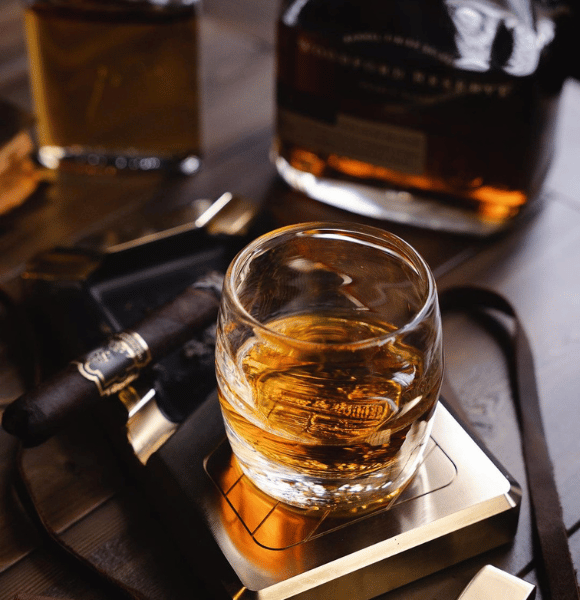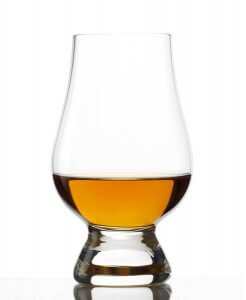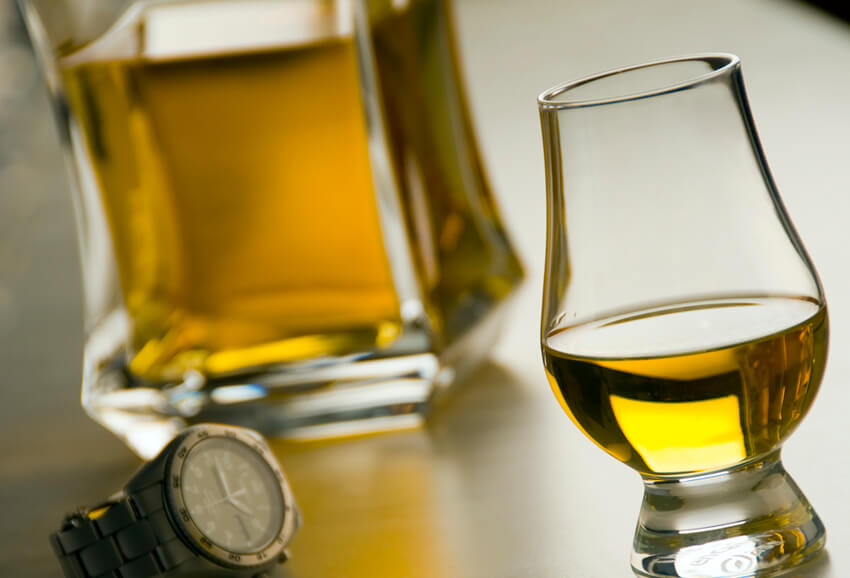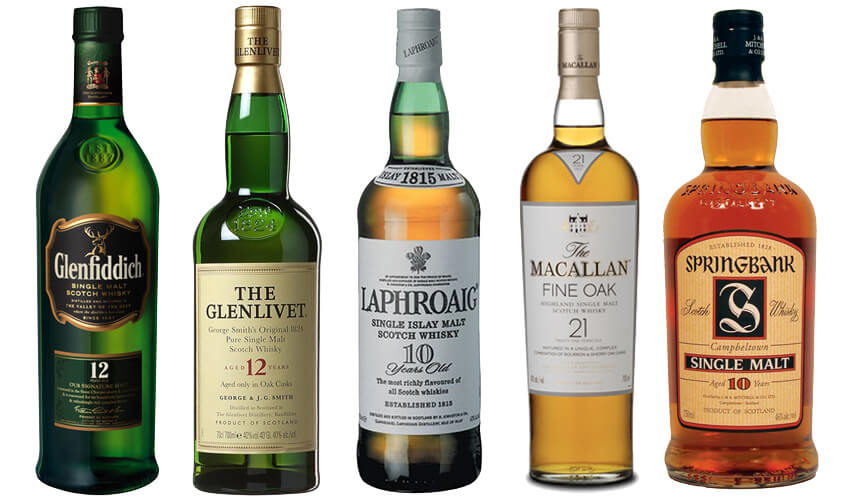Tale of Scotch Whisky
My first recollection of scotch whisky dates way back in my early childhood. I must have been around 5 or 6, I can’t remember, when my grandpa brought home a metallic black round case with elks image and embossed lettering on it. The beauty of the box sparked my curiosity about what’s inside.
Of course grandpa didn’t show me what’s inside. I supposed it’s something that grown ups use. Once his friend came and he took the box out of our small home buffet. He opened the lid and out came this beautiful green triangle-shaped bottle. I cannot tell you how delighted I was when I found out what was inside the box.
Grandpa placed two thick glasses on the table, opened the bottle and poured this brownish liquid into glasses. After that came few moments of silence as my grandpa and his friend sipped this liquid with their eyes closed. I was staring from down bellow at them wondering what in the heck is this that brings them such a joy.
They looked at me and told me that one day I will find out what are they enjoying so much. After some time I found out that they were drinking something called whisky. The particular brand that they were drinking that day, that beautifully shaped bottle, that great looking box, that was Glenfiddich (glen-fidd-ick).
Brief History of Scotch Whisky

Photo Credits @jeremysiers
It went many years from than that I had a chance and privilege to try some of that water of life, or in Gaelic usage usquebaugh, as it is originally called. Aqua Vitae in latin, whisky was originally used in medicine, it was used for the preservation of health, the prolongation of life, and as a cure for the relief of colic, palsy and even smallpox.
Legend says that St Patrick brought distilling to Ireland in the year 500 and that the process of distilling traveled to the Scotland when the Scots arrived in Kintyre. St Patrick gained distilling knowledge in Spain and France, countries proficient in distilling at that time. They applied the process of distilling first to perfumes then to wine. Since wine was not a common thing in Ireland and Scotland, barley beer was distilled into liquor which became whisky.
The art of distilling spirits was limited to apothecaries and monasteries until the late fifteenth century. Soon after the process of distilling became widespread to “common” folks and distilleries started to emerge all around Scotland.
Types of Scotch Whisky
Many of you think that whisky and whiskey are all the same, just spelled differently, but it’s not. Whisky refers to scotch made in Scotland, while whiskey refers to all other whiskeys made outside of Scotland. Scotland has internationally protected the term Scotch. So Scotch cannot be produced in England, Wales, Ireland, America or anywhere else. Since this article is about whisky and not whiskey I will cover only Scottish variants.
Scotch whisky is made of barley malt, smoked on a porous floor over peat fires before distillation. Several different varieties are blended together and then further diluted with a neutral grain alcohol. Single malt whisky is whisky that is not blended, and only 2 percent of the whisky sold is single malt. Scotch malt whisky must lay in oak casks for at least 3 years. Single malt whiskies are divided into five main regions as follows:
The Lowland region. Whisky made in Lowland distilleries is much softer and lighter in character. Lowland whisky is often very malty, with grassy characteristics and more subtle delicate aromas.
The Highland region includes most of the rest of mainland Scotland, hence a variety of characteristics can be found in Highland Malt Whisky. Highland whisky can range from very dry and heathery to sweet and with after taste of fruit. Some brands even have a slight touch of smoke due to their proximity to the west coast.
Speyside is a part of the Highland region and it is home to almost half of the malt whisky distilleries in Scotland. Speyside is pretty small area of land near Aberdeen and its whiskies are sweet, malty and very fruity.
The islands produce some of the strongest whiskies with coastal influences salty tang, fresh sea air, however, it is more specifically Islay that produces the heavy peaty, smoky tasting malts in particular the distilleries on the south coast of Islay.
Campbeltown was the home of the first distilleries in Scotland, but today only two remain. Whisky made in this area has more of a smoky taste.
Beginers guide to scotch whisky
Although Glenfiddich is excellent starter whisky, it was not the first whiskey that I tasted. When you are a teenager you don’t have any money and you definitely don’t have any taste. I don’t want to tell you which brands I tried first, but it was nothing worth enjoying and mentioning. Later in life when my taste became much more refined I started to enjoy the real stuff. After some time you start to tell the differences between the different brands and types of whisky.
Glenfiddich is a bit salty and slightly harsh on the tongue. It comes from Speyside area where you can find 46 distilleries. Another great malt from Speyside area is Glenlivet. It is full of flavor with a hint of smoke and leather. It may sound silly to you but once you taste it, it will make sense. Both malts can be mixed with a bit of water and you can put ice in them. Next in line is Laphroaig (la-froy-g). It is smoky, medium bodied malt. This is malt from the island of Islay where malts are strong flavored. Macallan, also called “Rolls Royce of single malts” is slightly sweet due to aging in sherry casks. It is very smooth and has no burn at all.
Now to the more pricier stuff. One of those is Springbank. Some people don’t like it, other appreciate its unique flavor. This whisky is distilled three times (opposed to usual two times) and is not chill filtered before. These five scotches are all well worth and if you are serious about really enjoying your whisky you have to try them.
How to Drink Whisky
Whisky and water? Whiskey and ice? Opinions on whether or not to do this vary widely, but the main joy of adding water to whisky is to “open” the flavors and discover nuances. There are plenty opinions on how much water to add. Some recommend 1/5 water, others profit half a half. Half scotch, half water.
Many whisky lovers say you should not bother drinking fine scotch with ice. Chilling does tend to detract from the overall taste experience. If you want to put ice in your whisky than it’s better to pour some cheaper stuff and leave the expensive brands without ice since true taste of whisky is enjoyed at room temperature.
If you are drinking scotch and water, the whisky tumbler is a great choice. Good whiskey tumblers are transparent and you can see your drink, marvel in its color which will give you a good idea of whether it’s too watered down or just right. For those who prefer scotch on the rocks, there’s nothing better than seeing a fresh tumbler full of ice and whisky .
 If you want to drink your scotch straight, you can do it in two ways. You can use a tumbler, or you can use a scotch tasting glass. Just like with wine or cognac glasses, scotch tasting glasses are specifically designed to enhance the flavors and bouquet of scotch. The aromas are directed by the design of the tasting glass in a way that the opening is delivering the scotch to your mouth in just the right way.
If you want to drink your scotch straight, you can do it in two ways. You can use a tumbler, or you can use a scotch tasting glass. Just like with wine or cognac glasses, scotch tasting glasses are specifically designed to enhance the flavors and bouquet of scotch. The aromas are directed by the design of the tasting glass in a way that the opening is delivering the scotch to your mouth in just the right way.
These glasses are made to enjoy scotch in its essence, without ice or water. The amount of whisky pictured in the glass is just about the amount you want to pour. The tasting glass maximizes your enjoyment with just right amount of scotch for finest results.
When buying whisky don’t be picky about the age of whisky since some younger dated can be better than the older ones. Age is important but your taste is even more so important. The best advice I can give you is to try some of the brands and ages at some bar before investing money into a full bottle.


